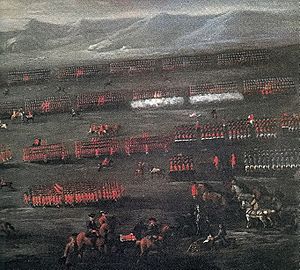Sir John Shaw, 3rd Baronet facts for kids
Sir John Shaw, 3rd Baronet (born around 1679, died 1752) was an important Scottish politician from Greenock. He was a member of the House of Commons for many years, from 1708 to 1734. Sir John was key in building the harbour at Greenock, which helped the town grow. He also played a big part in stopping the Jacobite risings, which were rebellions against the king.
Contents
Who Was Sir John Shaw?
Sir John Shaw came from a family that owned land in Scotland. His father, Sir John Shaw, 2nd Baronet, worked hard to make Greenock a busy port, like Glasgow. He especially wanted to raise money to build a proper harbour there.
Early Life and Family
Sir John Shaw, the younger, was the oldest son of Sir John Shaw, 2nd Baronet, and Eleanor Nicolson. He went to school in Glasgow in 1694. In 1700, he married Margaret Dalrymple. That same year, he became a "Burgess of Glasgow," which meant he was an official citizen with certain rights. When his father died in 1702, Sir John inherited the title of Baronet. He then took on his father's dream of building the Greenock harbour.
Building Greenock Harbour
Sir John Shaw owned properties in several areas, which gave him choices for where to run for Parliament. In the 1708 election, he chose to represent Renfrewshire and was elected without anyone opposing him. He and the people of Greenock raised their own money to build the harbour. The work was finished in 1710, with new docks reaching into the bay. Even though he didn't run in the next two elections (1710 and 1713), he kept working to improve how customs (taxes on goods) were handled in western Scotland.
Fighting for the King
In October 1714, Sir John Shaw celebrated the arrival of King George I in a grand way. He didn't run in the 1715 election, but he was very busy helping to stop the Jacobite rising. This was a rebellion by people who wanted a different king. Sir John fought in several battles, including the Battle of Sheriffmuir in November 1715. He worked closely with the Duke of Argyll, a powerful leader. In 1720, he became a burgess of Inveraray, the Duke's hometown.
A Voice in Parliament
With the Duke of Argyll's help, Sir John Shaw returned to Parliament. He was elected as a Whig Member of Parliament (MP) for Clackmannanshire in the 1722 election. He supported the government and voted for laws against those involved in plots against the king. He also spoke up when too many English people were given jobs in Scotland. He was active in helping the government during the "malt tax riots" in 1725, when local officials in Glasgow struggled to control angry crowds. For years, he had pushed for strong rules to stop goods from Ireland being illegally brought into Scotland. In 1725, he was given permission to "burn all boats" that brought grain from Ireland to Scotland.
Sir John was re-elected without opposition as an MP for Renfrewshire in the 1727 election. He continued to support the government. In 1734, he tried to get elected for Clackmannanshire again but was not successful.
Later Years and Legacy
During the 1745 Jacobite rebellion, Sir John and his wife helped gather support for the king's forces. They even raised a local militia (a group of citizens who act as soldiers) in Greenock, even though the rebels made threats.
Sir John Shaw died at Sauchie on 5 April 1752. When he died, his title of Baronet ended because he had no sons to inherit it. His daughter, Marion, had married Charles Cathcart, 8th Lord Cathcart, in 1718. She had a new building made at Nether Greenock Castle in the 1730s. However, when she died in 1733, the mansion went back to her father. After Sir John's death, his lands went to the family of his sister, Margaret. Her grandson, Sir John Stewart, later added "Shaw" to his name, and his family continued as the Shaw Stewart baronets of Greenock and Blackhall.


